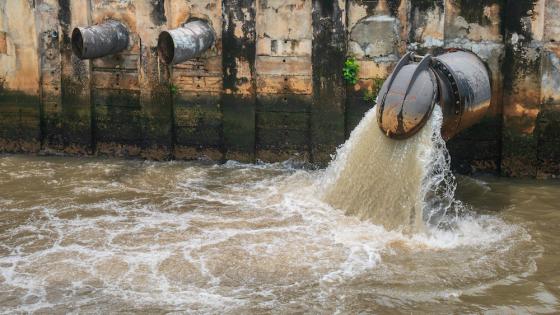Despite regulations by the US Environmental Protection Agency (EPA) that govern water quality, violations of these standards are alarmingly common. In 2015, the EPA reported over 12,000 health-based drinking water violations affecting about 27 million people across the country, or nearly 1 in 12 Americans. In fact, an estimated 16.4 million cases of acute gastroenteritis are attributed to contamination in community water systems in the US each year (Messner et al. 2006).
Waterborne or water-based diseases, such as acute gastroenteritis, can result in severe health consequences, including hospitalisations or even death for vulnerable individuals. Less severe health consequences may go unmeasured in traditional health data. For example, common symptoms such as nausea, vomiting, diarrhoea, and stomach cramps may not be severe enough to warrant hospitalisation but may result in over-the-counter purchases of common stomach remedies, absence from school, or lower test scores.
Children, in particular, are vulnerable to environmental health threats, and disadvantaged children are disproportionately exposed to poor water quality. This differential exposure may contribute to existing socio-economic gaps in health and human capital accumulation. For example, the average Black American still scores below 75% of the average white American on almost every standardised test, according to the Brookings Institution. Education is a proven avenue for improving income, job stability, and social mobility (Chetty et al. 2014, 2011), making it imperative to understand and address the root causes of disparities in educational outcomes.
To do so, it is critical to understand disparities in educational inputs and to quantify their impact on student achievement and education. Much of the economics research in this area has focused on factors traditionally thought of as key inputs driving educational outcomes, including school-related inputs such as class size, tutoring, and teacher quality (Burgess et al. 2023, Guryan et al. 2023, Chetty et al. 2011, Krueger 1999), the role of families and peers (Hoekstra et al. 2016), and nutrition (Hanemaaijer et al. 2023, Ruffini 2022, Anderson et al. 2018). Yet, the role of environmental factors, such as drinking water quality, are often overlooked.
Poor quality drinking water harms health and human capital accumulation
My two recent studies shed light on the significant impact of poor water quality on both health and educational outcomes. In Marcus (2022), I find that violations of the Total Coliform Rule (TCR) – the most commonly violated drinking water standard – significantly harm health and human capital accumulation. Specifically, TCR violations significantly increase purchases of common stomach remedies, emergency room (ER) visits for gastrointestinal illness, and school absences. Violations increase emergency room visits for gastrointestinal illness by 23% among school-aged children. While costly, considering ER visits alone would greatly understate the overall consequences of poor-quality drinking water. Violations also increase over-the-counter stomach remedy purchases by 23% of a standard deviation and increase school absences by 5%.
In a new study (Marcus 2023), I extend the evidence to show that TCR violations during the school year also decrease mathematics test scores by 0.037 standard deviations. These effects on test scores persist and are driven to a large degree by reduced retention or comprehension of material presented in the classroom. The magnitude of this effect is comparable to the effect of about $822 less in school spending per student, an increase in class size of about four students, a reduction in teacher quality of about one third of a standard deviation, or a one standard deviation increase in fine particulate matter (Jackson et al. 2021, Ebenstein et al. 2016, Jepsen and Rivkin 2009, Rivkin et al. 2005). Using estimates from Chetty et al. (2014), the estimated effect of poor water quality on test scores is associated with a decrease in lifetime earnings of about $2,722 per child exposed.
Policy implications and the importance of public information
Public notification and information play a pivotal role in addressing the consequences of poor-quality drinking water. When the public is promptly informed of water quality violations, individuals are more likely to take precautionary measures, such as switching to bottled water.
The evidence shows that timely public information matters a lot in protecting health. In the case of TCR violations, two types of violations can occur that differ in their public notification requirements. “Acute” violations require the public to be notified within 24 hours, while “monthly” violations require public notice within 30 days. When the public is informed immediately (i.e. within 24 hours), I find a large increase in bottled water purchases and no evidence of negative health consequences (Marcus 2022). Alternatively, when the public is not notified immediately, there is no increase in bottled water purchases and significant negative impacts on ER visits, stomach remedy purchases, school absences, and test scores.
These findings underscore the importance of public notification rules as a crucial policy lever to encourage avoidance behaviour and mitigate the harmful consequences of exposure to drinking water contamination. Recent revisions to the TCR in 2016 removed testing requirements for monthly violations, assuming they had no direct health impact. However, this research suggests otherwise, highlighting the need for immediate public notification and continued testing to protect households, particularly children, from the harmful effects of exposure to contaminated water.
Conclusion
The findings I present here emphasise the urgent need to address the issue of poor quality drinking water, even in high-income countries like the US. Beyond the immediate health risks, the impact on education and, consequently, long-term economic prospects for affected individuals underscores the significance of this problem. Policy actions, such as reinstating testing requirements for monthly TCR violations and ensuring immediate public notification, are vital steps in safeguarding the health and future of millions of Americans. By taking proactive measures to provide clean and safe drinking water, we can help close existing gaps in health and education, ultimately reducing inequality and improving overall health and wellbeing.
References
Anderson, M L, J Gallagher and E R Ritchie (2018), “School meal quality and academic performance”, Journal of Public Economics 168: 81–93.
Burgess, S, S Rawal and E Taylor (2023), “Teachers’ use of class time and student achievement”, VoxEU.org, 19 February.
Carrell, S E, M Hoekstra and E Kuka (2018), “The long-run effects of disruptive peers”, American Economic Review 108(11): 3377–415.
Chetty, R, J N Friedman and J E Rockoff (2014), “Measuring the impacts of teachers II: Teacher value-added and student outcomes in adulthood”, American Economic Review 104(9): 2633–79.
Chetty, R, J N Friedman, N Hilger, E Saez, D W Schanzenbach and D Yagan (2011), “How does your kindergarten classroom affect your earnings? Evidence from Project STAR”, Quarterly Journal of Economics 126(4): 1593–660.
Ebenstein, A, V Lavy and S Roth (2016), “The long-run economic consequences of high-stakes examinations: Evidence from transitory variation in pollution”, American Economic Journal: Applied Economics 8(4): 36–65.
Guryan, J, J Ludwig, M P Bhatt, P J Cook, J M V Davis, K Dodge, G Farkas, R G Fryer Jr, S Mayer, H Pollack et al. (2023), “Not too late: Improving academic outcomes among adolescents,” American Economic Review 113(3): 738–65.
Hanemaaijer, K, O Marie and M Musumeci (2023), “Devoted minds: Ramadan’s influence on exam performance”, VoxEU.org, 2 September.
Hoekstra, M, E Kuka and S Carrell (2016), “The long-run effects of disruptive peers,” VoxEU.org, 25 April.
Jackson, C K, C Wigger and H Xiong (2021), “Do school spending cuts matter? Evidence from the Great Recession”, American Economic Journal: Economic Policy 13(2): 304–35.
Jepsen, C and S Rivkin (2009), “Class size reduction and student achievement the potential tradeoff between teacher quality and class size”, Journal of Human Resources 44(1): 223–50.
Krueger, A B (1999), “Experimental estimates of education production functions”, Quarterly Journal of Economics 114(2): 497–532.
Marcus, M (2022), “Testing the water: Drinking water quality, public notification, and child outcomes”, Review of Economics and Statistics 104(6): 1289–303.
Marcus, M (2023), “Testing above the limit: Drinking water contamination and test scores”, NBER Working Paper 31564.
Messner, M, S Shaw, S Regli, K Rotert, V Blank and J Soller (2006), “An approach for developing a national estimate of waterborne disease due to drinking water and a national estimate model application”, Journal of Water and Health 4(S2): 201–40.
Rivkin, S G, E A Hanushek and J F Kain (2005), “Teachers, schools, and academic achievement”, Econometrica 73(2): 417–58.
Ruffini, K (2022), “Universal Access to Free School Meals and Student Achievement Evidence from the Community Eligibility Provision”, Journal of Human Resources 57(3): 776–820.



